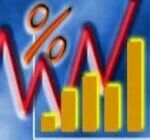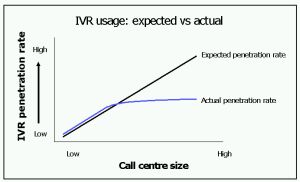 With 57 per cent of usage, email is the most relevant mean of customer contact after telephony in UK, being used in a larger scale by smaller and more flexible contact centres like the IT vertical market. Interactive Voice Response (IVR) facilities are only used by an average of 34 per cent. Mostly adopted by larger centres, IVR has already reached though its saturation point with a penetration ceiling of no more than 50 per cent. These conclusions can be found in a study carried out by ContactBabel to around 3,000 call and contact centres in UK.
With 57 per cent of usage, email is the most relevant mean of customer contact after telephony in UK, being used in a larger scale by smaller and more flexible contact centres like the IT vertical market. Interactive Voice Response (IVR) facilities are only used by an average of 34 per cent. Mostly adopted by larger centres, IVR has already reached though its saturation point with a penetration ceiling of no more than 50 per cent. These conclusions can be found in a study carried out by ContactBabel to around 3,000 call and contact centres in UK.
If finance vertical market leads both on call centre size and inbound/outbound activities, the usage of email accounts for only 49 per cent, whilst smaller operations like IT helpdesk and legal services reach the highest penetration rates, with 76 and 78 per cent respectively.
This suggests that the larger operations may be extremely focused upon telephony, and do not wish to add another layer of complexity to existing operations, or may be running out of physical space in which to accommodate new agents. It may also be the case that some of these businesses have not integrated email with telephony yet, as the project cost and size can be substantial for large operations, the study concludes.
 Indeed, the study spots a slight negative correlation between the size of contact centres and the level of email adoption to communicate with customers. Sixty per cent of the 10-50 agents contact centres deal with customers e-mails, while only 51 per cent of the 1,000-3,000 agents centres gave a positive answer.
Indeed, the study spots a slight negative correlation between the size of contact centres and the level of email adoption to communicate with customers. Sixty per cent of the 10-50 agents contact centres deal with customers e-mails, while only 51 per cent of the 1,000-3,000 agents centres gave a positive answer.
According to the study, larger centres like telecoms, financial services and utilities, apart from having lower levels of adoption, are more likely than other vertical markets to deal with email separately.
It is possible that this schism between email and telephony customer contact is one of the causes of the appalling reply rates which many customer suffer via email channel. Contact centres must realise that customers do not care about the companys internal layout. If customers send a letter, fax or e-mail to the company and then phone them up, the customer rightly expects the company to be sufficiently organised to respond sensibly to the overall inquiry, ContactBabel notes.
Contact centres using IVR facilities more than average are likely to be found in the utilities (49 per cent), finance (48 per cent), motoring (46 per cent) and transport and travel (45 per cent) sectors. Public services (15 per cent), sales/marketing (15 per cent), and engineering/construction (11 per cent) vertical markets rank last.
 There is a positive correlation between the size of contact centre and the use of IVR facilities. Nevertheless, the ascending graph line reaches its peak at the 150-200 agents contact centres, stabilising from there on: 51 per cent of the 150-200 agents centres use IVR, exactly the same percentage of the 1,000-3,000 ones.
There is a positive correlation between the size of contact centre and the use of IVR facilities. Nevertheless, the ascending graph line reaches its peak at the 150-200 agents contact centres, stabilising from there on: 51 per cent of the 150-200 agents centres use IVR, exactly the same percentage of the 1,000-3,000 ones.
This does suggest that commercial decisions not to use IVR have been made. What should be of concern to suppliers is the usage ceiling which seems to have been reached long before a 100 per cent penetration rate has been hit , the study warns.
According to ContactBabel, IVR suppliers have a very hard nut to crack. Smaller centres are still a virgin territory for the implementation of these solutions, but the absence in many cases of a suitable sales model, the expense of selling directly and the as-yet unproved status of hosted applications means that small contact centres are beneath the radar screens of many of the larger IVR vendors. Add to this that only a proportion of this sector will be interested in IVR, and the divide between IVR applications and small contact centres is plain to see.
On the other hand, IVR is not very popular amongst consumers who call to the larger centres, which in many cases divert these bigger operations from implementing these solutions. Vendors need to look at why businesses are wary of using IVR. Poorly-implemented IVR is the main problem, where the system is expected to do everything for the business.
The study states that government and the public sector area is a good ground for the implementation of IVR solutions. Local government especially, which tends to have many departments, may benefit from an IVR routing solution rather than the present system of having a receptionist answering the phone.
Furthermore, ContactBabel alerts to the inconvenient of contact centres having disparate platforms of communication. This must change: the advent of the IP contact centre is an ideal opportunity for contact centres to phase out their telephonic-centric model, and to treat all forms of contact in the same manner using a universal queuing model.
Filipe Samora
2003-02-10
Source (data and charts): ContactBabel. All data report to 2002.
ContactBabel is a UK-based analysis firm focusing upon the global contact centre and CRM industries.
Em Foco – Pessoa

